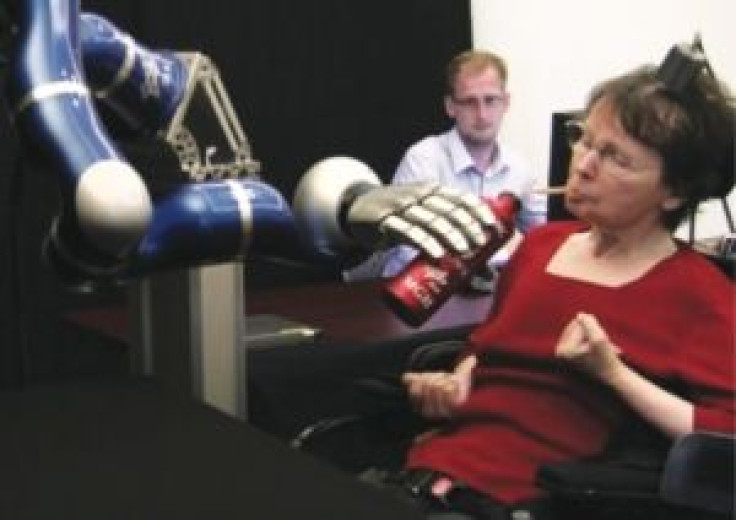Mind-Controlled Robotic Arms Give Hope to the Paralyzed

A paralyzed woman can control objects with just her mind. No, this not the X-Men but thanks to a brain-controlled robotic arm, the woman took a drink from a cup, by herself, for the first time in 15 years.
The 58-year-old woman, dubbed S3, is part of a clinical trial that is testing out this cutting edge technology. The BrainGate neural interface system may bring some control back in the lives of the paralyzed.
S3 has been paralyzed for 15 years and has not been able to speak. Using The BrainGate, S3 was able to reach for a bottle of coffee and take a drink. The BrainGate is a Brain-Computer Interface (BCI) that lets the user control a robotic arm thanks to a device implanted in her brain.
S3 just has to think about the action and the robotic arm will perform it. S3 is enrolled in a clinic trial that is led by Dr. Leigh Hochberg and is a part of The BrainGate Collaboration, which features researchers from the Department of Veterans Affairs, Massachusetts General Hospital, the Harvard Medical School, the German Aerospace Center and Brown University. S3 is joined by T2, a 66 year-old man who is also paralyzed.
Both S3 and T2 were paralyzed by a brainstem stroke causing them to lose all control of their limbs. The individuals had a small device implanted into the motor cortex section of the brain.
The motor cortex is involved in voluntary movement and motor skills. The device responds to movement-associated neural activity. The device than transmits the activity to the robotic arms, enabling the arm to move and grab what the user wants. Dr. Hochberg notes that despite the motor cortex being unable to control the limbs of S3 and T2 due to the brainstem stroke; it was still able to control the robotic arm.
The science behind this advancement began 10 years ago by neuroscientist John Donoghue from Brown University. S3 had the device implanted five years ago. S3 and T2 had two robotic arms that represented the left and right limbs.
One robotic arm was developed by the DEKA Research and Development Corporation, known as the Luke Arm informally, and the other robotic arm was developed by the German Aerospace Center. Each of the arms have unique features, the DEKA arm has a wider grasp while German Aerospace Center arm has fingers to more closely mimic a human hand.
S3 and T2 underwent a series of experiments during the study, including timed trials to touch an object as well as grasping an object. S3 successfully touched her target 48.8 percent of the time using the German Aerospace developed arm and 69.2 percent of the time using the DEKA arm. T2 touched the target, in the allotted time, 95.6 percent of the time using the DEKA arm during 45 trials. S3 grabbed the target 43.6 percent of the time using the German Aerospace arm and 66.8 percent of the time using the DEKA arm. T2 grabbed the target 66.2 percent of the time, similar to S3’s performance with the DEKA arm.
The clinical trials are evaluating safety and effectiveness of the BrainGate in a real-world environment, which includes three-dimensional movement and commands such as grabbing the bottle, tipping the bottle and settling the bottle back down. These encouraging results are just the beginning for the BrainGate.
The study was published in Nature.



























